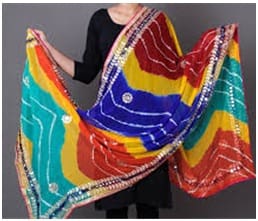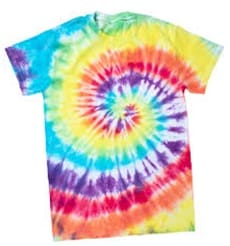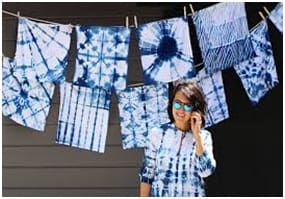What is Tie and dye? Before we jump into tie and dyeing, let us take a look at some basic concepts.
Everything we see has hues, tints, tones and shades. Wondering what did you just read?

It is all the dimensions of colour and we use colours to make things unique, decorative and long lasting. Tie and dye is one of the uniquely beautiful techniques we employ to decorate fabric with long lasting effects and unique colours.
Hues are the names of the colours we see like blue, red, green, and yellow and so on. Tints are the colours in their lighter form. Similarly tones are the colours in greyish forms and shades are the colours in their darker form. For example, Pink is a tint of red in its lighter form and brown is a mixture of orange red and yellow in darker form.So now as we know what colours are and what they do let’s learn about what are dyes and what is tie and dye.Dyes are colours in the form or pigments and chemicals that are used to improve or brighten or darken the colour of the fabric.

It could be colored in one or many colours. As we can see in an Indian sari the border is of one colour, the embroidery is of another, petticoats is of different colour and even the blouse has its own uniqueness.We see the different colours and the colours look different on different types of materials. With the similar example, blouse is adorned with brocade which uses golden metallic coloured thread or yarns and the petticoat is mainly cotton or linen based which is matched with the colour of the saree itself. And the Sari includes pallu with embroidery with coloured or dyed threads and the use of lace and beads.

Bandhini is the most prominent known tie and die technique used to make small bead like texture on the fabric as well as depict figures and stories on it with the same. It is famous in Rajasthan and Gujarat. But the both differ in the intensity, colours and fineness. Small dals, beads or stones are used to resist the fabric while tie and dye.

Leheriya is the other very famous technique used which gives an effect of waves on the fabric. It is very soothing and soft texture like looking dye and mostly uses white as one colour and a primary or different colour for the second or third colour. Different very material takes different steps and dyes to get dyed and to stay long lasting.
Tie and dye is a technique where colour or dye is applied through various methods but are also resisted or stopped from entering special parts of the material or fabric. For example a  rubber band or a thread is tied around a fabric tightly that nothing enters it; then after immersing the fabric in the dye bath the colour does not penetrates or stamps over the area which results in designs and unique patterns. This is what encompasses Tie and dye. Tying in a way that the fabric is dyed but also reflects designs and ideas on it by resisting in the desired areas.
rubber band or a thread is tied around a fabric tightly that nothing enters it; then after immersing the fabric in the dye bath the colour does not penetrates or stamps over the area which results in designs and unique patterns. This is what encompasses Tie and dye. Tying in a way that the fabric is dyed but also reflects designs and ideas on it by resisting in the desired areas.
Sometimes when we buy something from the market, we find the colour is not fast and bleeds on washingor fades on wearing. No amount of resist or external factors fastens the colour applied. This is improved by using various techniques and selecting colours and dyes with care. It is important to know these facts because when we do We have to use colours and tie and dyeprocess accordingly for an imperfectly-perfect pattern. Now let’s understand what is Tie and dye.
For tie and dye various fixers, dyes and machinery are used. These can be natural or man-made, new or old, better or worst. Natural includes anything that comes from nature as in red chilies, turmeric, berries and bark of trees, leaves, soil and many more.

For example turmeric is used for yellow colour, chilies for red colour, spinach leaves for green colour and tea for brown or black colour. And man-made are vat dyes, direct dyes, saturated dyes and many.
Natural may fade easily if not applied properly. Man-made could be less environment friendly if used in production houses as well. One has to keep balance between the two. Here is where science step in
- Salt is used to fix the colour so that it absorbs and sticks to the fabric, fibers and yarns.
- Fastness depends on the bonding between the chemicals – it can be strong or weak depending on the dye.
The start of dyeing was first done on faded clothes or torn clothes as a way of DIY (Do it yourself), for rejuvenation. And if anything goes wrong one can force remove the dye as well by the use of “stripping” or discharging agents.It means destroying the dye with a powerful agent like Sodium Hydrosulfite, hydrogen peroxide or sodium hypochlorite. These agents may be easily found at home or vailable at nearby grocery shops like bleaching powder and ala. Similarly dying can be done at home by using dyes, salt, big spoon, hot water, rubber bands, thread, gloves, a bucket or a large bowl enough to dye the article and the fabric most effectively cotton.
Here is a quick way DIY!
Prepare the dye mixture by dissolving it in a container with water. Prepare the fabric by pre washing and drying it. Then you dip the fabric, the dye and water in one bucket and leave it for a substantial amount of time and then rinse it with cold water. Try testing the dye on a patch of fabric before dying the whole article.

There are many methods to tie the fabric; it includes tying, knotting, marbling, shibori, folding, tritik, bandhini, leheria and lots more. Rubbing wax on the tying material could give it more resistant and finer finish. Also one can search Batik painting where only different types of waxes are used for resisting. After all the work is done you can change or intensify the colour by keeping it longer in the bath.If you are planning to use different colors try dying it first with the lighter colour then the darker colour.
You can make different products by using this technique like t-shirts, scarves, poncho, headbands, bags, kaftans, beach wraps, stoles, aprons or anything you like.

Do try this at home and share pictures of the unique product created, as no two articles are same & we are sure you are going to love your own DIY pattern!
Share your DIY tie-dye products at – @fashionvaluechain (Instagram) and we will feature them all!
Toodles!!
Article By:
Ragini Gupta
Intern at Textile Value Chain.
P.G Student, Department of Textile Science and Apparel Design
SNDT Women’s University

